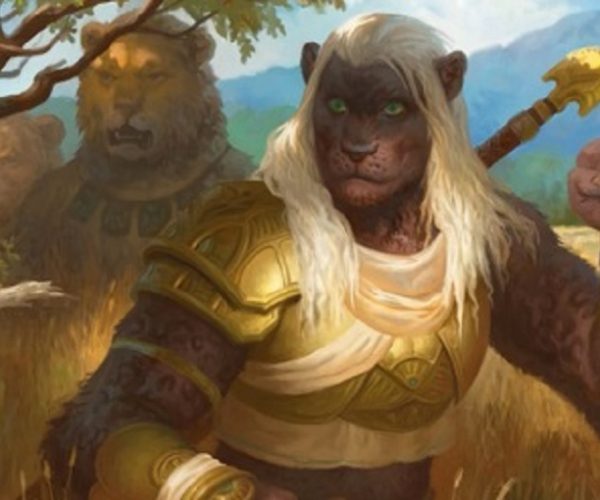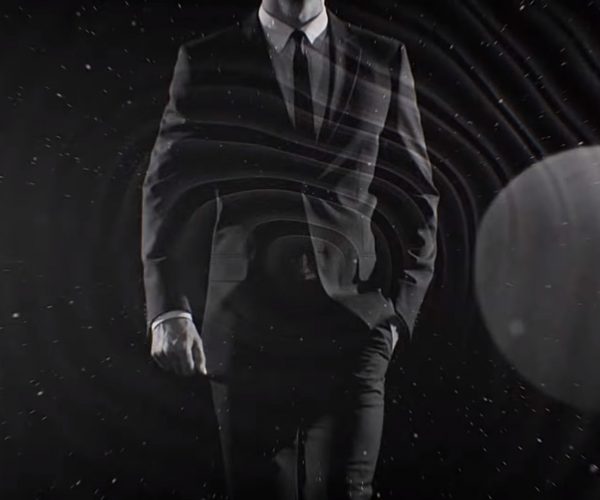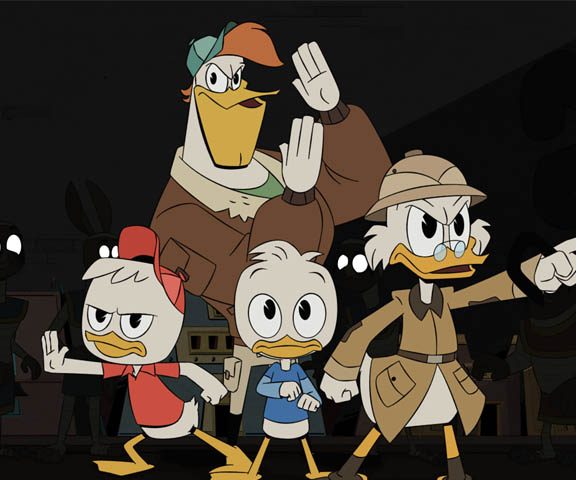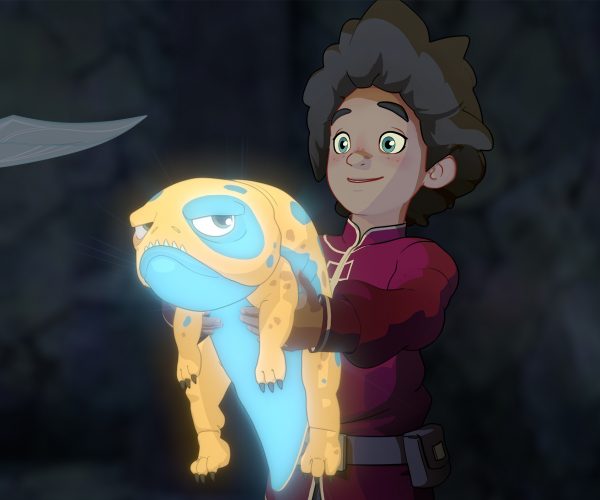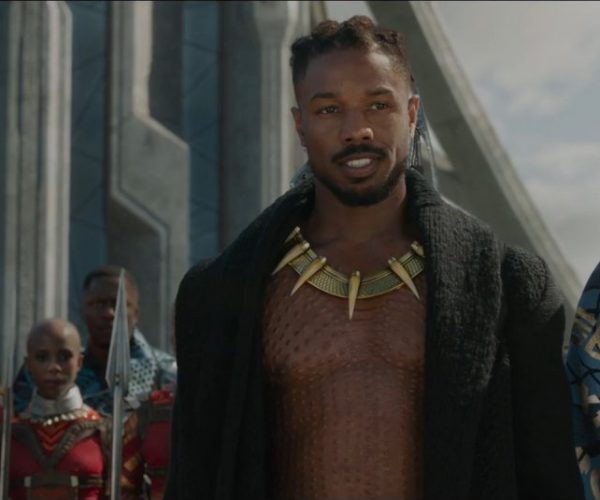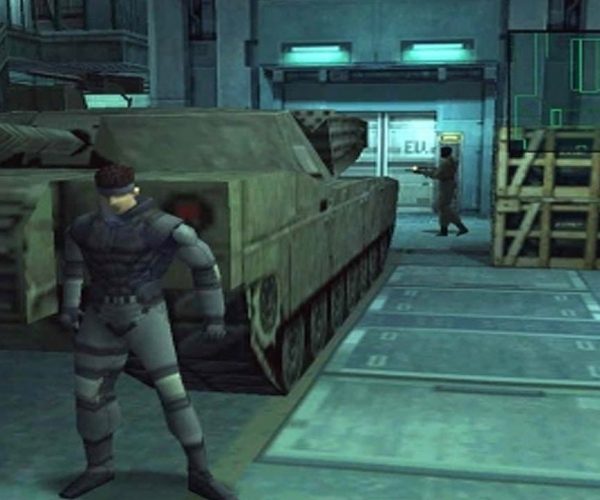Already the setting of two of Magic: The Gathering’s most popular expansion blocks, the plane of Ravnica is more endearing to the game as any other in its long and fabled history. And this is exactly where Wizards of the Coast will be taking us on Oct. 5 with it releases Guilds of Ravnica, the first of three expansion sets that will take place in this popular world.
Ravnica is best described as a massive, planet-wide city that reaches all ends of its plane of existence. Think Coruscant with the only difference that fans actually like the setting. For tens of thousands of years, ten different and unique warring clans tore the plane to ribbons with their squabbles, and peace was not achieved until they all settled down and agreed to cast the Guildpact, an agreement that stated that none of the guilds would hinder one another’s business.
And until the present day of Magic’s canon, this business includes operating the many functions of a city. The power supply, the laws, the banks, the underworld, and even the sewage, balance is kept in this world with each guild finding its place and purpose in a society.
Guilds of Ravnica, the latest story taking place on the popular plane, sees the legendary Elder Dragon Nicol Bolas tearing through the multiverse with his army of undead super-zombies to lay waste to one of the only planes capable of foiling his long-term ambitions. The crafty dragon looks to disrupt this balance by recruiting some of the more susceptible guilds to his cause, but the Gatewatch, Magic’s version of The Avengers, is also based in Ravnica and is tasked with thwarting him.
Interesting setting, no doubt, but Ravnica is also endearing for giving the different two-color combinations a name they can go by. Blue/Red, Black/Green, White/Black… without Ravnica, we wouldn’t have names for these combinations.
Only five of these guilds will be represented in Guilds of Ravnica, so we’ll focus on these five today. The others set to appear in the following two sets.
Boros
Red/White
The Boros Legion, the Red/White guild of Ravnica, is the plane’s most militaristic, combining Red’s love of chaos with White’s desire for control Humans, minotaurs, goblins, giants, Boros’ iconic race, Angels, and anything that can pick up a sword or an axe and swing it into an enemy’s face usually ends up in this guild.
Boros is responsible for creating Ravnica’s army to fight off invaders and keeping the peace within the city walls as its police force.
As you can imagine, in terms of gameplay, this is the most straightforward and one-dimensional guild. Playing Boros colors will usually mean you’re job is to find aggressive creatures with a lot of power or burn spells that clear blockers from your attacking threats or directly hit opponents in the face. Keep the pressure up, play cheap, powerful spells every turn, and don’t give your opponent to stablize. If they do, Boros’ in-your-face tactics won’t stand a chance against big Green creatures, powerful Black removal, or Blue control magic.
Encapsulating common:
Common cards are what you’ll see most when you draft a set of Magic, so we’re going to pick out a common from each guild that best encapsulates what you’re trying to do.
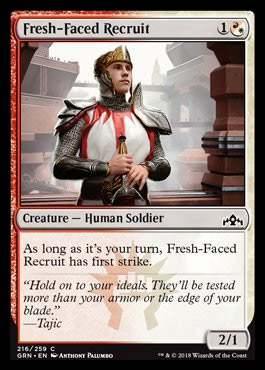
Absolutely perfect in every way. This is a hybrid creature, meaning Red or White mana can be used to cast it. As we said, Boros wants to get started quickly and keep the pressure up, and nothing hinders that plan more than not having the right mana in your opening hand. With Fresh-Faced Recruit, you’ll never have to worry about that since any mana can cast it!
The 2/1 stats are nice and aggressive for a two-mana creature, and first strike is one of the most ideal abilities for a Boros creature to have, allowing it to win almost any combat in the first two or three turns of the game. This card’s downside is that the creature only gets first strike when it’s attacking, making it an awful defender.
However, attacking is all you really want to be doing in Boros. If you’re keeping your cheap creatures back to defend, you’re plain doing it wrong and dragging out a game you’ll eventually lose. Attack, attack, attack!
Selesnya
Green/White
Humans have long turned to religion to explain the elements, making Green’s fondness of nature tied to White’s desire for order a perfect guild for the churches of Ravnica. The Selesnya Conclave acts just as that, employing wise elves, anthropomorphic elephants called Loxodons, Centaurs, Dryads, and tamable beasts like Hyrdas to spread the word of the deities of nature.
As you might guess, no guild in Ravnica is innocent as they claim, but none are seen as more guilty of this than Selesnya, which roots its foundations in the ideas of peace and unity while murdering those who speak out against them.
Selesnya’s gameplay also revolves around smaller creatures, but unlike Boros, players will want to hold back longer. Selesnya is the classic “go-wide” color combination, crowding the board with small blockers to defend against threats, preserving life totals with abilities like lifelink, and ultimately winning the game by delivering a huge Green threat that nothing can stand up to. It’s a risky color combination since dragging the game on against Blue and Black leaves those threats open to punishment. However, Red’s direct damage spells will usually ping off of them like a mosquito.
Encapsulating common:
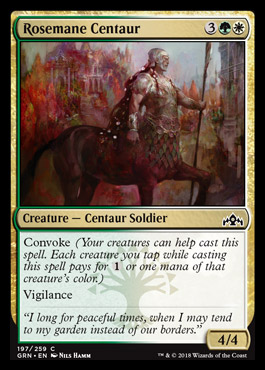
Brutal. 4/4 is a solid pair of stats on a common creature, and Vigilance is an ability that stabilizes any board. Rosemane Centaur can attack as an early, big Green threat but still be left around as a defender, playing to both of Selesnya’s needs to close the game.
What makes this all the more dangerous in Convoke, an ability that Wizards giving to Selesnya is bound to piss off a lot of players. With this ability, casting a creature on turn-1 and one turn-2 usually means you’ll have enough presence on the board to have a three-mana, turn-3 4/4 creature with a relevant ability. No cards spoiled yet in Guilds of Ravnica can rumble with this card if it comes down that early.
Even later in the game, a two-mana 4/4 vigilance creature is no laughing matter, making this a card that’s noteworthy at any point in the game.
Izzet
Blue/Red
Red’s love of chaos combined with Blue’s thirst for knowledge leads to some explosive discoveries. The Izzet League is all about experimentation, combining the power of magic and mana with electricity to create power sources. It is headed by one of Magic’s most endearing and popular characters, Niv-Mezzit, an arrogant, outspoken dragon and the most intelligent being on the plane, maybe even the whole multiverse.
Under his leadership, the humans, fairies, goblins, and fellow dragons and drakes of Izzet operate as a personality cult, pushing the technology and creativity of Ravnica at his whim.
One of Izzet’s main characters, Ral Zarek, is also a Planeswalker, a fact unknown to Niv-Mezzit, and has close ties with Nicol Bolas, hinting that the conflict of Guilds of Ravnica might find its initial spark within the Izzet League.
Izzet’s gameplay revolves around spells and creatures that benefit from spells. Dominaria’s Wizards and one of my all-time favorites, Enigma Drake, will find a perfect home working with Izzet’s Red burn spells and Blue card draw spells. The idea is to outsmart your opponent with Izzet, controlling the board with direct damage or counterspells and drawing enough cards to never run out of ammunition to fire at them. Eventually, a burn spell or a creature will be able to close out the game.
Encapsulating common:
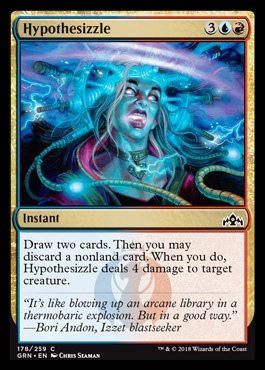
Somebody get me a checklist, “Draw two cards,” yup! “You man discard a nonland card,” sure, whatev. “Deal 4 damange to target creature,” oh yeah!
Hypothesizzle is awesome, and in a game of Magic that has gone on too long, it can easily turn the tide of the game. What’s bound to happen when you cast this is you’ll get two cards, filling up your hand, and then you’ll obviously want to discard something. Discarding a useless creature or a burn spell that only does 2 or 3 damage already generates more value through Hypothesizzle than it would have if you had cast it anyway!
So that’s essentially three cards worth of value… and then you will most likely kill any creature that’s on the board with 4 damage. It’s a three-for-one in the best case scenario, and easy way to take control of a game on turn-5.
And, I still dream that Snoop Dogg is a Magic player and Wizards turn to him to come up with that amazing card name.

Golgari
Black/Green
Black’s ambitious embrace of death and Green’s natural tendencies towards life created the Goglari Swarm, rulers of Ravnica’s agriculture and underworld. The Gorgons, Bugs, Spiders, Oozes, Plants, Fungus, Saprolings, Dark Elves, and pretty much every other dark being in Magic never lived up to that ambition since their jobs entail harvesting food for the rest of the city and then, wallowing in the poop of the other nine guilds.
Literally, the underworld, meaning the world directly under the city.
The Golgari accept their lot as in life as stuck in a never-ending cycle of life and death. No breaks, no love, no need for anything else but the slow ambitious crawl to grow, expand, and become more powerful beyond the observing eyes of the other guilds… while feasting on their poop. The true cycle of life and death, a never-ending resources.
Dark and necromantic tendencies bring its inhabitants and leaders back to life as well, meaning a guild that never dies is also, naturally, the largest. Waiting below the city, slowing growing, ever expanding, just for its moment. Yeah, Golgari is pretty sweet after all, despite being a guild populated entirely by fecalphiliacs.
Vraska, who last appeared in Ixalan with Jace, is a Golgari gorgon and a planeswalker who directly works for Nicol Bolas and is expected to push the Golgari to help him. However, unlike Izzet, the Golgari host a Green mana, one that does not align with Bolas’ Red/Blue/Black Grixis combination.
Encapsulating common:
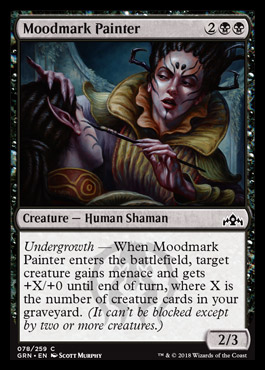
We don’t have a good multicolored common card spoiled just yet, but this one still fits the bill. As per the beliefs of the Golgari, even in death, all creatures have a purpose, A full graveyard of throwaways creatures only means more power for your long-term goals of victory.
With this card, for four mana, you get a 2/3 body, which admittedly isn’t that great. But, if played later in the game, this card transforms any creature into a legimiate threat, with a huge surge in power and an evasive ability. With enough patience, that creature will either deliver a huge blow to an opponent or force them to lose two creatures. Does your creature die? Doesn’t matter, more fodder for future spells, and you get value out of death where your opponent might not!
Does your 2/3 stand a chance? Doesn’t matter. Throw it in the way for a chump block, more fodder for future spells. And the cycle of life and death continues.
Dimir
Blue/Black
Blue’s thirst for knowledge through Black’s ambitious drive for power, the House of Dimir only hypothetically exists with many believing its ceased its operations long ago. Rarely do its members raise their heads, but its vampires, spirits, and horrors still carry on its operations, acting in secret as the spies and back alley dealers of Ravnica.
Dimir thrives on knowledge, knowing what’s coming in your deck next, knowing what your opponent is going to play. With that knowledge, Dimir players will cripple the opponent’s ability to play anything by surprise and play around their threats with threats of their own.
Also notice that Dimir shares a mana alignment with Nicol Bolas as well, covering the Blue/Black portion of his Red/Blue/Black preferences.
Encapsulating common:
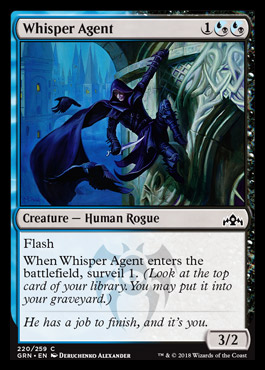
What a sweet Magic card. Dimir isn’t usually my style, but I can’t wait to play this! Flash is the perfect ability for a Dimir agent, ambushing an unsuspecting attacker or jumping onto the battlefield at the end of your opponent’s turn, catching them totally off-guard.
And even if that 3 points of damage results in the death of both creatures, you still get value by filtering out your deck with suveil, a new ability that will help ensure you’re casting the spells you want to cast. Knowledge is power, and knowing what’s coming next can make all the difference in your plans.




